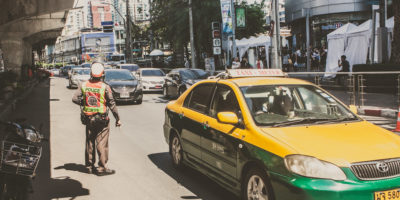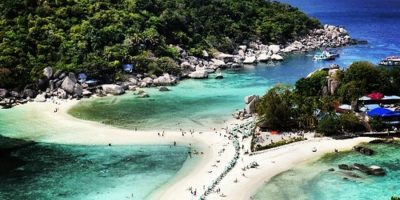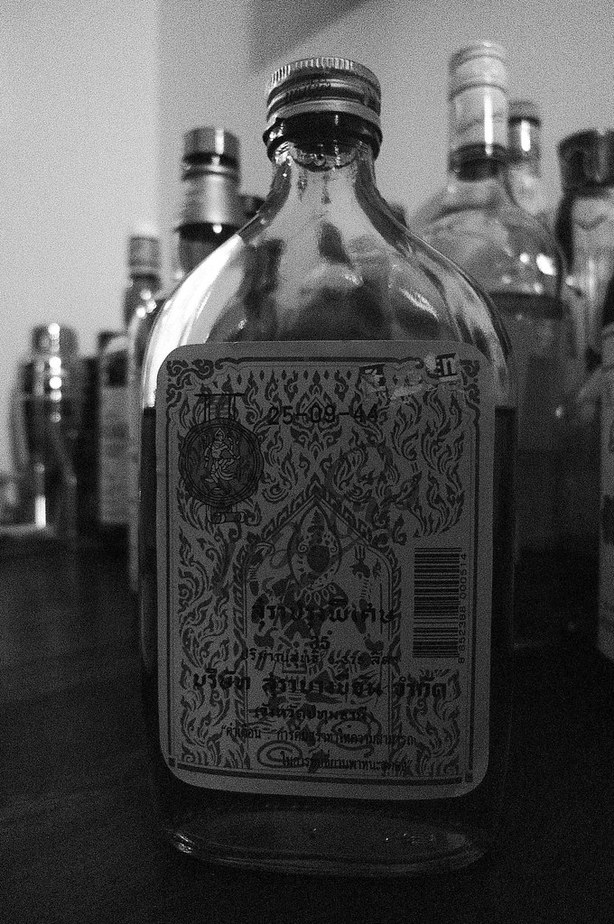The Top 12 Thai Spirits You’ve Probably Never Heard of
Originally published by Mark in October 2021 and updated by Felix in March 2024
If you’ve never been to Thailand you might be under the impression that everyone in the SE Asian nation is a smiling, teetotal, vegetarian Buddhist.
And indeed there may be some vegetarians in Thailand, a country that is also regarded as being a ‘Buddhist’ nation in terms of any formal religious classification.
But the teetotal bit? Mmm.
Well, OK – not everyone is a drinker – but plenty are. It could be the farmers and other low-income, blue-collar workers drinking cheap and strong ‘legal moonshine’ (by way of the infamous 40% proof distilled-rice spirit ‘Lao Khao’). Or it could be the office-level and upwardly hi-so types with their respective grades of Johnnie Walker to suit their incomes.
In fact, the availability and consumption levels of alcohol in Thailand have led at some points to the Kingdom being included in the global top five when it comes to alcohol consumption per capita.
To put that into a little more perspective, let us just backtrack for a minute to 2004, when the then Prime Minister Taksin Shinawatra made a somewhat bizarre move to try and curb the rate of alcohol consumption. (As a point of note, the former minister is now exiled from Thailand – which probably had nothing to do with him bringing in this new law.)
He decided to change the laws regarding the authorized hours for the sale of alcohol. This led to the rather puzzling permitted hours of alcohol sales that are still in place today, from midnight until 11.00 am, with further restrictions in the afternoon between 14.00 and 17.00.
Of course, it is worth mentioning that such prohibitions are not (ahem) ‘strictly’ observed by all sellers, but the rule is most obvious in the high street 7-Elevens and such. This ‘window’ for the purchase of alcohol also extends to supermarkets.
So the days of bars, restaurants, and even shops selling alcohol 24/7 are long in the past in Thailand, although there are seemingly still a fair few drinkers in the nation who don’t have a problem working around that. Either way, drinking forms an integral part of socializing in Thailand for a high proportion of the population.
And although locally-brewed beers like Chang, Singha, and Leo are popular, it has to be said that spirits play an even larger part in the Thai culture of drinking. You only have to look around any bar or restaurant with a group of Thais to see the customary bottle on the table along with an ice bucket and soda. Whiskey and soda is big in Thailand.
Or ‘anything’ with ice and soda, as the case may sometimes be.
The term ‘whisky’ is somewhat generic in Thailand, and is often applied to pretty much any kind of spirit other than wine or beer. Which can be a little confusing for visitors who are offered ‘whisky’ that actually turns out to be rum, rice vodka, or some other blend of spirits.
And it is possible these days to find imported spirits in varying proportions in Thailand, to the point where even the standard 7-Elevens have a bottle of Absolut and Johnnie Walker Black Label next to a bottle of red and white wine above all the much cheaper locally-made products.
And there are always innovative entrepreneurial types in Thailand, particularly in Bangkok, who are looking to create or add to current or existing trends. It is this spirit that is behind the growing range of craft beers that have been appearing on shelves and in bars in the last few years.
And we’ve now reached a point where certain companies are producing ‘top shelf’ whiskies and vodkas of a quality equal to their Western counterparts, although the majority of these brands are unknown to the main proportion of the Thai populace.
So what we are most interested in with this post is the range of spirits and whiskies that are locally produced, and most of them are long-established. They are largely unheard of outside of Thailand, and it may be true that in many countries the quality might be deemed questionable, as anyone who’s ever been out drinking ‘SangSom’ will testify (if you know, you know).
But that’s probably just a matter of taste.
And it also needs to be remembered that in many Western countries with strict governing regulations and even stricter tastes, the price will always trump quality. In SE Asia though, the opposite is true, at least for all but the moneyed classes who remain just a small minority of the population.
Strong Alcohol in Thailand
Cheap & cheerful is the name of the game for the majority of Thai consumers who indulge in the odd drink or three when it comes to spirits.
And there have long been available various brands of Thai spirits, whiskies, and rums that certainly hit the mark in terms of alcohol content – there’s no issue with that one. But the majority are produced strictly for the local market (for reasons previously touched upon).
If you know the difference in terms of taste and quality between a Bell’s and a Black Label, then this post probably holds little interest for you. However, if you are interested in how that compares to local equivalents of spirits in Thailand, then read on.
With that in mind let’s have a look at some of the top Thai spirits that you’ve probably never heard of.
1. SangSom
Most Thai drinkers believe this to be whisky but it is actually the most renowned Thai rum (for various reasons) on the market. It is actually a pretty popular local drink but is not necessarily for rum connoisseurs.
Produced from Thai sugar cane and has a strength of 40% proof (which is apparently a little questionable in terms of stability). The rum has reportedly been awarded various international medals along with being exported to 20-odd countries, although its export sales account for only one percent of total sales.
It is usually mixed with soda and ice by locals.
On the more extreme side though, this is also the spirit that is usually mixed into the legendary ‘bucket’ drinks found on the Thai ‘party islands’. It is mixed with other delights such as red bull and Coke and should be avoided at all costs for more reasons than we have space to list here.
Sangsom is very much on the cheap side compared to international brands and is sold in large 70cl bottles and half bottles (the complete contents of which will go into your ‘bucket’, and the follow-on ‘hangover from hell’). Don’t say you haven’t been warned.
2. Mekhong
This is the drink that is almost on a par with Sangsom, and although it is again often given the ‘whisky’ moniker, it is also distilled largely from sugar cane and rice (on a 95/5 percent ratio) to a mere 35% proof.
It is named after one of the largest rivers in the country, if not in SE Asia, and sold in small, flat-looking half bottles as well as the larger 70cl ones.
Mekhong ‘whiskey’ was the first spirit to be produced domestically in Thailand (at least legally) on a mass scale in 1941, around the time that Thailand had reclaimed territory previously lost to the French colonialists.
It initially came from a privately-owned company that was eventually taken over by the government, whose intention was to reduce the amount of revenue being spent on imported whisky (as well as stoke a bit of patriotism). Eventually, the rights were leased out by the government and these days it is owned by the massive Thai Beverage Inc.
It is actually a little cheaper than Sangsom, so make of that what you will. Honestly not one for whisky (or rum) connoisseurs, but nevertheless gets the job done in terms of alcohol content, as many a Thai security guard will attest to.
3. Hong Thong
Hong Thong (translated as ‘golden phoenix’) is another very cheap and cheerful ‘whisky’ from the Thai Beverage Company that also has more ‘H’s than is necessary for the spelling.
This one probably requires even more mixer than is usual with the previous 2 options. It is nevertheless very popular with certain factions of the locals in Thailand and is often paired with soda, coke, and a few snacks.
Like the other ‘whiskies’ Sangsom and Mekhong, Hong Tong is also made largely from molasses, which is no surprise really considering how easily sugar cane grows in Thailand.
So by now, you are probably getting the idea about how Thai ‘whisky’ has little to do with grain, taste, or even quality — and everything to do with price, alcohol content, and available natural resources (in this case being sugar cane and, to a lesser extent, rice).
Hong Thong is another 35% proof Thai spirit, and is also sold in flat, small bottles and standard 70cl bottles.
4. Lao Khao
Officially described as a Thai distilled spirit, ‘Lao Khao’ — which translates as rice whisky – is the strongest, the cheapest, and absolutely the most popular spirit in Thailand for the lower end of the low-income classes. It’s 40% proof and distilled from main rice, with a taste and smell guaranteed to strip paint from 10 paces away.
Lao Khao is the closest thing to moonshine that is legally available in Thailand and is particularly popular among the populations of the North and Northeast. You are unlikely to find it in any restaurants or bars, but every 7-Eleven and side street local store shifts tons of the stuff on a daily basis.
So yes it is safe to say that the majority of consumers who drink this stuff (which is usually on a daily basis) remain blissfully unaware of the fact that it plays no small part in the figures for alcohol-related deaths and health issues and that they are in fact abusing alcohol.
Lao Khao comes in dark brown bottles that look a little like beer bottles, and there are 2 different sizes with a volume of 0.33 litres and the larger 0.625 litres.
The labels are all in Thai, with different colors to signify the grade and alcohol content, which is somewhere between 28% and 40%. The blue-labeled one is the strongest, and hence best-selling option, and you’ll see the discarded empty bottles on pretty much every road and street corner in Thailand.
This Thai spirit is not mixed with ice and soda and is drunk neat. It is strictly for hard-core drinkers on a budget, and any foreigners making the mistake of trying to buy it from a store usually attract blank and genuinely puzzled stares.
5. Meridian
This list wouldn’t be complete without at least a nod towards one of the growing number of Thai brandies on the market.
Generally more expensive than the other spirits produced in Thailand, the brandies like this one are aimed at a slightly higher class of drinker, and a half bottle costs as much as a full bottle of the other spirits. This is for the Thai tippler who thinks himself above the bottom-end brands like Mekhong and Sangsom but doesn’t quite feel up to the level of imported brand consumers (which is related more to earnings than taste).
Regency was one of the best-known Thai brandies available until quite recently when Meridian V.S.O.P. was introduced in an obvious attempt to steal the market. It seems to have succeeded as the majorly-stocked item in 7-Elevens and such like.
The United Winery & Distillery is the company behind Meridian and is again part of ThaiBev. Like all Thai brandy, this one is marketed as a quality and high-end product. Unfortunately, it is neither, especially when making any kind of comparison with international brands.
Again still largely considered as a whiskey by the general population, this Thai spirit is made from pineapples. The marketing blurb states that the brandy is ‘distilled in a copper pot imported from Cognac in France and left to age in limousine oak for 4 years.’ But that is about as close to a French brandy as it gets.
Meridian is usually drunk with…soda and ice.
6. Ya Dong

Photo by Adam Jaime on Unsplash
Ya Dong, a traditional Thai herbal liquor, is a beloved elixir deeply ingrained in local culture. Frequented by both locals and adventurous travelers, it’s often enjoyed in vibrant street-side stalls or quaint roadside shops. Its affordability, often priced reasonably, makes it accessible to all, fostering a communal atmosphere where stories flow as freely as the liquor itself.
Despite its humble origins, Ya Dong’s complexity of flavors and medicinal properties elevate it beyond mere spirits, offering a sensory journey through Thai tradition. Whether shared amongst friends or savored alone, Ya Dong embodies the heart and soul of Thailand’s spirited culture.
7. YadongGao
In the heart of Thailand’s bustling streets, YadongGao reigns as a mystical elixir, whispered about in hushed tones among the locals. Infused with an ancient alchemy of herbs and spices, it dances on the palate with an enigmatic allure, teasing the senses with every sip. Its origins steeped in tradition and folklore, YadongGao transcends mere spirits, embodying the essence of Thai mysticism.
Whether sought for its medicinal virtues or its tantalizing taste, this ethereal potion beckons the adventurous soul to delve into the depths of its secrets, unlocking a world where spirits roam freely in the realm of YadongGao.
8. SraaJaow
Unlike any other alcohol, SraaJaow is a traditional Thai moonshine with an air of mystery. Its essence, distilled covertly in secret stills, embodies the unadulterated soul of Thailand’s rural landscapes.
SraaJaow is unique because of its covert manufacturing and strong kick, which represent the tenacity and ingenuity of the Thai people. Tasted with the wild spirit of the land and the whispers of generations before, each scorching sip reveals more of the past.
Its distinctiveness comes from both its manufacturing processes and its capacity to whisk drinkers away to a world where tradition and adventure converge and leave a lasting impression on the spirit.
9. Yaa Dong Dam

Photo by Josh Olalde on Unsplash
Here is something more than just a drink; the famous Yaa Dong Dam. Every drop of the mysterious and dark herbal liquor Yaa Dong Dam tells a story of healing and tradition. It is crafted by carefully combining strong herbs and spices, embodying the traditional knowledge of Thai herbalists. Its rich, enigmatic flavor profile, which echoes with notes of spice and earthiness, is what draws people in.
Often valued for its therapeutic qualities, Yaa Dong Dam offers an exploration of Thailand’s herbal knowledge that goes beyond simple infusion.
This mysterious spirit invites the inquisitive to discover its mysteries, one sip at a time, whether they are drawn to it for its rumored health advantages or its alluring flavor.
10. KlongKhrong

Photo by Vianney CAHEN on Unsplash
KlongKhrong, a hidden gem of Thai libations, whispers of tradition and reverence. Born from the fertile soils of Thailand’s rice paddies, this traditional rice wine embodies the spirit of ancient rituals and cultural ceremonies.
Its name, evoking the serenity of waterways and the depths of tradition, hints at its profound significance. With each sip, one is transported to the heart of Thai culture, where the rhythm of life flows as freely as the rivers that inspired its creation.
KlongKhrong invites the adventurous to embark on a sensory journey, where the essence of Thailand’s heritage is bottled for all to savor.
11. Sato PhuYai

Photo by Domagoj Horak on Unsplash
The best thing about Sato PhuYai is its embodiment of time itself, distilled into a liquid elixir. Crafted from meticulously selected glutinous rice and aged to perfection, it carries the wisdom of generations within its amber depths. Each sip unveils layers of complexity, revealing a symphony of flavors that dance upon the palate.
But beyond its exquisite taste, Sato PhuYai transcends mere spirit; it is a vessel of cultural heritage and tradition, a testament to the enduring spirit of Thailand. In its embrace, one finds not just a drink, but a profound connection to the soul of a nation.
12. Lao Hai

Photo by Moritz Mentges on Unsplash
Last on the list is this beloved spirit, Lao Hai. Many people love Lao Hai for its ability to encapsulate the essence of camaraderie and celebration within its potent depths. This traditional Thai rice wine, often shared during festivals and special occasions, fosters a sense of unity and joy among friends and family. Its smooth yet robust flavor profile, tinged with hints of nostalgia and tradition, evokes cherished memories of laughter-filled gatherings and heartfelt toasts.
Lao Hai’s accessibility and affordability further enhance its appeal, making it a beloved staple of Thai social gatherings. In each shared sip, one discovers not just a drink, but a symbol of cherished connections and shared moments of happiness.
As I delved into the spirited world of Thailand, I unearthed hidden treasures beyond the familiar Mekhong and SangSom. From the mystical depths of Ya Dong to the ancient allure of SraaJaow, each sip unveils a tapestry of flavors, traditions, and mysteries. Embark on this intoxicating journey, and let the spirits of Thailand enchant your soul
Planning a trip to Paris ? Get ready !
These are Amazon’s best-selling travel products that you may need for coming to Paris.
Bookstore
- The best travel book : Rick Steves – Paris 2023 – Learn more here
- Fodor’s Paris 2024 – Learn more here
Travel Gear
- Venture Pal Lightweight Backpack – Learn more here
- Samsonite Winfield 2 28″ Luggage – Learn more here
- Swig Savvy’s Stainless Steel Insulated Water Bottle – Learn more here
Check Amazon’s best-seller list for the most popular travel accessories. We sometimes read this list just to find out what new travel products people are buying.


















